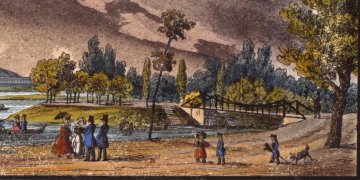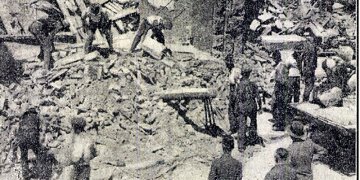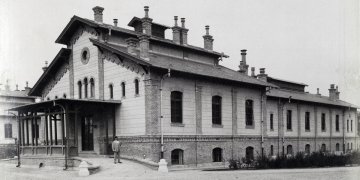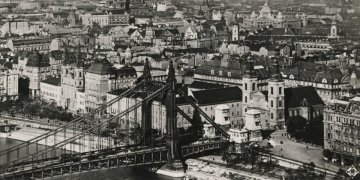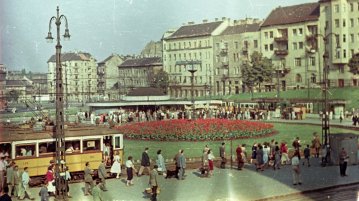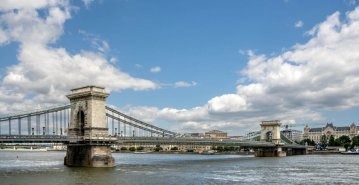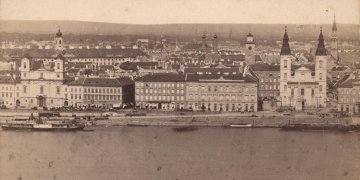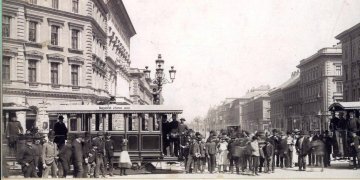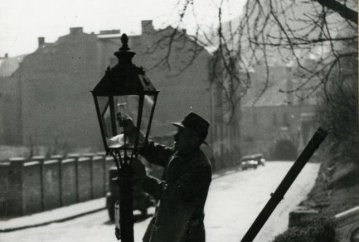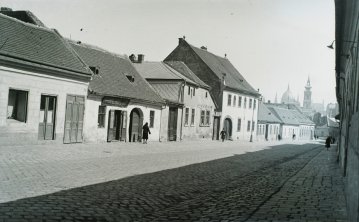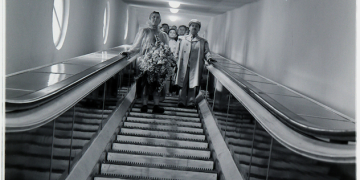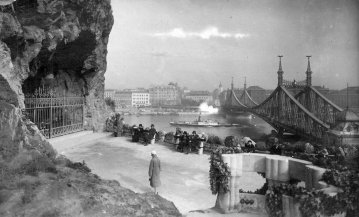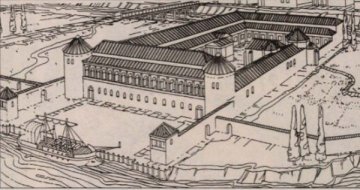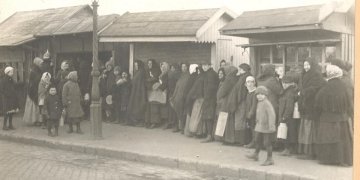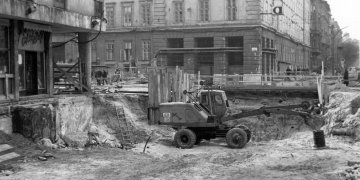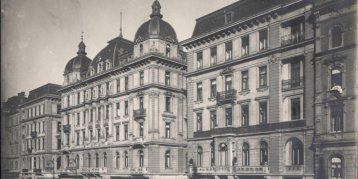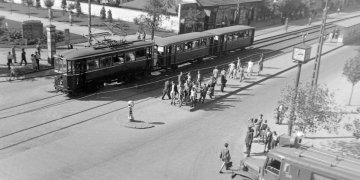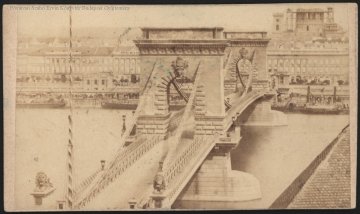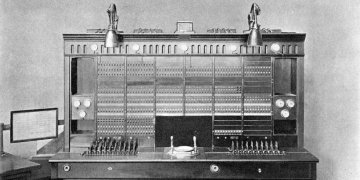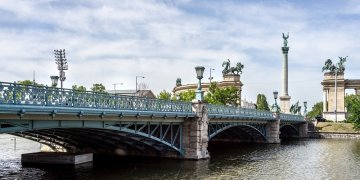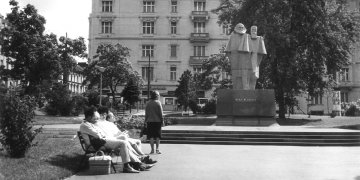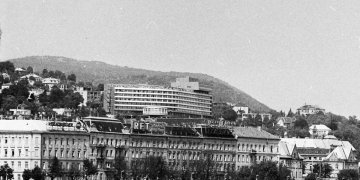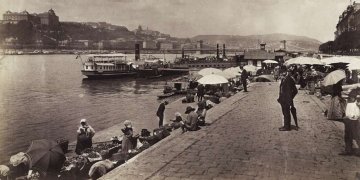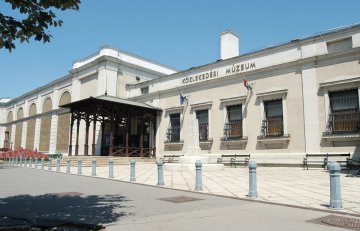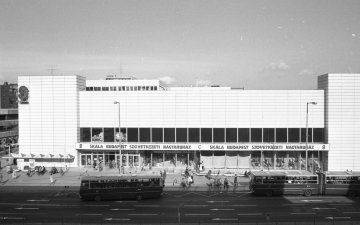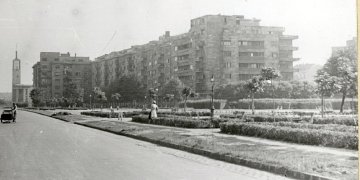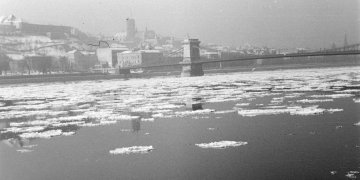
Domonkos Csaba
Cikkek
They wanted to call the first suspension bridge in Pest the István Bridge, eventually it was called Dróthíd (Wire Bridge)
August 9, 2021 at 3:00 PM
Wire bridge. It’s a strange name, though that’s how the little bridge, which was handed over 195 years ago, on 9 August1826, in the Városliget, near today’s George Washington statue, was called. The small footbridge was a new technology at the time, as it was a cable bridge and the first suspension bridge in Pest.
The Buda Castle under constructionwas also visited by Maria Theresa, who visited the capital in 1751
August 4, 2021 at 3:00 PM
Although she gave permission to expand the Buda Castle, Maria Theresa visited Pest and Buda only twice. Her first visit took place in August of 1751, the 11th year of his reign, 270 years ago. This was when the diet was held in Bratislava and during that time the royal court spent a few days in Pest and Buda.
House collapsed in Angyalföld - The tragedy 90 years ago claimed the lives of eight people
July 21, 2021 at 9:30 AM
The whole of Budapest was shaken by the misfortune that took place 90 years ago and claimed the lives of eight workers. During construction, a house collapsed in Angyalföld, Szent László Road.
Reporting infectious patients was ordered 140 years ago in Budapest
July 3, 2021 at 9:00 AM
Diseases and epidemics are part of our history, as we have seen in the last year and a half. In the XIX. century people began to recognize how each disease spreads and how to prevent them. The new epidemiological rules came into force in Budapest 140 years ago, on 1 July 1881. The obligation to report, and quarantine still helps to control epidemics today.
Only one-third of the apartments in Budapest had bathrooms in the 1930s
June 20, 2021 at 12:00 PM
In the first half of the 19th century, the facilities of apartments in Budapest did not even come close to what is usual today. According to statistics from 1930, 23 per cent of homes did not have plumbing, only a third had a bathroom, and just over half had a toilet.
Széll Kálmán Square became a transport hub 80 years ago
June 18, 2021 at 9:30 AM
There was once a clay mine and then a sports field on the site of today's Széll Kálmán Square, where the tram junction and the pedestrian overpass, which defined the image of "Kalef" for decades, were completed 80 years ago, in June 1941. Then, in the middle of the square, a roundabout was created for trams, from where vehicles could depart in all directions. Modern passenger waiting areas and bus terminals were also built, but the development did not fully win the favour of the contemporary public.
Changing Chains – 12 elements of Chain Bridge to be modified during reconstruction
June 16, 2021 at 11:30 AM
Chain Bridge has been completely closed, and its renovation has begun in earnest. The 172-year-old bridge has been remodelled several times, first in 1914-1915, then it was rebuilt after World War II, and most recently, it underwent major renovations in the second half of the 1980s. So now the iconic structure of the capital is being renewed again. But what work will be done on the Chain Bridge over the next two years?
160 years ago, the city of Pest declared war on dirt roads
June 11, 2021 at 9:00 AM
Today, Budapest's road network typically consists of paved roads. Although there are still dirt roads, their number is constantly decreasing. In Budapest, the paving of streets started relatively late, but 160 years ago, the city of Pest adopted a decree on what paved roads should look like.
One hundred and fifty years ago, the law on the construction of the Outer Ring Road was given royal consent
June 9, 2021 at 9:00 AM
A flood drain, a navigable waterway serving industrial sites, or a more elegant route? In the 19th century, several plans were made for the location of the Outer Ring Road. The issue was closed by law 150 years ago.
The first gas lamp in Pest was lit 205 years ago
June 3, 2021 at 9:00 AM
The aldermen of Pest were given plenty to think about when providing night lighting on the city streets in the 18th century, so in 1715, they forbade staying on the street without a candle or lantern after sunset. Lantern-bearers appeared, carrying candles and oil lamps in front of pedestrians. Oil lamps began to be put out in public spaces at the end of the century, but they only gave little light. The solution was the gas lamp, the first of which was set up in Pest by a scientist, experimenting physician, Lajos Tehel, on 5 June 1816. The lamp was lit up on the facade of the university building on today’s Egyetem Square. Now it is part of the National Museum’s collection.
Vehicle entry to Buda Castle first restricted 35 years ago
May 31, 2021 at 3:00 PM
Today car access to the castle is limited, and only midi-buses run within its ancient walls. Restrictions on access were introduced 35 years ago because traffic endangered historic buildings and the caves beneath the streets of the castle.
Campaign launched against rats 90 years ago in Budapest
May 28, 2021 at 10:00 AM
A war against rats was launched in the capital in 1931, but a mistake slipped into the thorough and long-planned campaign. Fewer rats died than planned, and there were many "civilian" casualties, like dogs, cats, and birds.
Metro escalator tested in Hűvösvölgy terminus of the Children's Railway
May 27, 2021 at 10:00 AM
An escalator transported passengers for a few years from May 1956 at the Hűvösvölgy terminus of the Children's Railway. It was built as a kind of test. Its primary purpose was not to ensure the comfort of the passengers on the Children's Railway, then called the Pioneer Railway, but to educate the operators and users. At the time, the Budapest metro was already under construction, and the escalator needed testing too.
The first statue of Saint Stephen in Budapest was completed in 1906
May 25, 2021 at 10:00 AM
The statue of Saint Stephen has been standing in Buda Castle next to the Fisherman's Bastion for 115 years. Although the founding king of Hungary has always been highly respected in the country, the great work of Alajos Strobl was completed slowly. The first statue of King Stephen in Budapest was inaugurated in 1906 next to Matthias Church almost 40 years after it was first planned.
A place of worship in a cave – Cave Church turns 90
May 24, 2021 at 2:00 PM
One might think that the Cave Church on the side of Gellért Hill is an old church, although it is surprisingly young, not a hundred years old, as construction of the chapel itself began in 1924 and it was consecrated in 1931. During the communist era, a reinforced concrete wall closed it off from worshippers, which was only demolished in 1992.
Remains of Hadrian's palace on Hajógyári Island were found 170 years ago
May 20, 2021 at 10:00 AM
Hadrian was one of the most successful emperors of the Roman Empire. Once, he was the governor of the province of Pannonia. His governor's palace, built in the 2nd century, was in the settlement of Aquincum. The remains of the former huge building were discovered 170 years ago when the Óbuda shipyard expanded its site. The ruins have since been excavated several times on today's Hajógyári (Shipyard) Island.
Food kitchens alleviated the misery of the war in Budapest 105 years ago
May 17, 2021 at 9:00 AM
Although World War I did not directly affect the home front, Budapest was not bombed by the enemy like in World War II, but because of the battles, the capital was struggling. In 1916, the state wanted to help. Food kitchens were set up to deliver vegetable dishes and pasta to the poorer quarters of Budapest.
Construction of blue Metro Line M3 began 50 years ago
May 13, 2021 at 9:00 AM
The development of the Budapest underground network entered a new phase 50 years ago when the construction of the city’s third metro line began. Although the ideas changed a lot and the work planned for 15 years took 20, today’s Metro Line 3 is one of Budapest's most important transport corridors.
The Royal Hotel hosted the first film screening in Hungary 125 years ago
May 11, 2021 at 9:00 AM
Fortunately, the Hungarian Academy of Sciences set the date of the Hungarian conquest of the Carpathian Basin as 896, rather than the originally planned 895. In 1896, the official national millennium was celebrated with miracles such as the first domestic film screenings. The general public could see the screenings in two places: that of the Lumière brothers were held at the Royal Hotel, and Edison’s were shown in Lágymányos.
Shortest suburban railway line in Budapest turns 70
May 7, 2021 at 10:00 AM
Suburban railway lines (HÉV - helyiérdekű vasút) have been running from Boráros Square to the 21st District for seventy years. Csepel had a rapid transit connection before, with trains running on Gubacsi Bridge. The suburban railway line to Csepel is record-breaking in many aspects: it is the shortest line, the site of the most serious accident, and currently home to the oldest trains.
Neither Pest nor Buda wanted a private company to build the first bridge in Budapest – the bridge law is 185 years old
May 4, 2021 at 9:00 AM
A law promulgated 185 years ago made it possible to build the first permanent Danube bridge connecting Buda and Pest. A long debate preceded the adoption of the bridge law because neither Pest nor Buda supported a private company building the bridge, as they did not want to waive their customs rights.
Tivadar Puskás built the first Hungarian telephone exchange 140 years ago
May 3, 2021 at 9:00 AM
The first telephone exchange started operating in Budapest on May 1, 1881. Tivadar Puskás and his brother Ferenc built the equipment. Initially, the phone centre had only 25 subscribers, but its popularity grew steadily. Based on the telephone network and the telephone exchange, Tivadar Puskás's truly great invention, the Telephone Herald (Telefonhírmondó), was born and presented at the Millennium Exhibition.
Second life for the bridges of Budapest?
April 30, 2021 at 9:00 AM
Recently, an announcement was published about reusing the pieces of the soon-to-be-demolished Southern Railway Bridge in Budapest for other, smaller bridges, such as connections to Hajógyári Island. At first glance, it sounds like a rather strange idea to create a new bridge from a used one, but it is not uncommon at all, even in Budapest. There are several bridges in the capital, the elements of which were once parts of other structures.
The statue of Marx and Engels inaugurated fifty years ago
April 28, 2021 at 12:00 AM
The theoretical foundations of communism were laid by a German philosopher and a wealthy German merchant. Neither of them were workers, yet they hatched plans for a perfect state of workers. In addition to Lenin, socialism considered Marx and Engels to be the “apostles” of the system. Their portraits hang in all the most notable places and events, yet a statue of the two founders was only erected in Budapest relatively late, in 1971 on Jászai Mari Square.
The SZOT Resort on Rózsadomb opened 50 years ago – Cable-car for guests never completed
April 18, 2021 at 9:30 AM
One of the most controversial buildings in Budapest, the SZOT Resort on Rózsadomb, has been part of the cityscape for half a century. The huge 114-meter-long building of the health resort once accommodated up to 500 guests at a time, who were transported to the nearby Lukács Baths by a minibus. Contrary to the original plans, neither a cable car nor a lift was built. The gigantic house later stood empty for decades, but today it has been reborn as a luxury residential building.
The longest monuments in Budapest: the history of the embankments
April 12, 2021 at 9:30 AM
Until the middle of the 19th century, anyone could walk down to the undeveloped, muddy banks of the Danube, but during a flood, nothing stood in the way of the water. The 12-kilometre-long embankments along Budapest's Danube Banks have become an essential part of the cityscape and protect the capital from floods. In connection with the freshly announced reconstruction of the Pest embankment, Pestbuda presents the history of these magnificent structures.
Museum of Transport opened 55 years ago after post World War II repairs
April 5, 2021 at 1:00 PM
After a more than a two-decades-long forced break, the Museum of Transport opened in City Park on 2 April 1966. During World War II, in 1944, several bombs hit the building. Although the most valuable works of art were saved, the destruction was still immeasurable: in addition to the building, the bombing also caused significant damage to the collection.
The first modern shopping centre in Budapest – The Skála store in Buda opened 45 years ago
April 2, 2021 at 9:00 AM
There was a store in Buda that brought new colour and new quality to the slow socialist state store system. The modern design, the huge floor space of more than 22,000 square metres, and the relative abundance of goods contributed to the rapid rise in the popularity of the Skála store, which opened 45 years ago on 2 April 1976.
Szent István Park turns 85 – A parquet factory once sprawled across the greens
April 1, 2021 at 9:00 AM
The green that opened on 1 April 1936 was originally called Lipótváros Park, then Rakovszky Park. It was given its current name in 1937 and has been called Szent István Park ever since. The site of the beautiful ornamental garden was once a parquet factory, and its construction was initiated in the 1920s by the President of the Public Works Council at the time, Iván Rakovszky. Újlipótváros' most popular park is 85 years old.
A blast saved Budapest from icy floods 65 years ago
March 16, 2021 at 10:00 AM
The sad year of 1956 brought other disasters than the brutal defeat of the revolution. Pestbuda has already reported on the earthquake in January, but another disaster struck the country in March. A huge flood wreaked havoc south of Budapest, and special measures were needed to protect the capital. Ice blocks were blown up near Kossuth Bridge.

